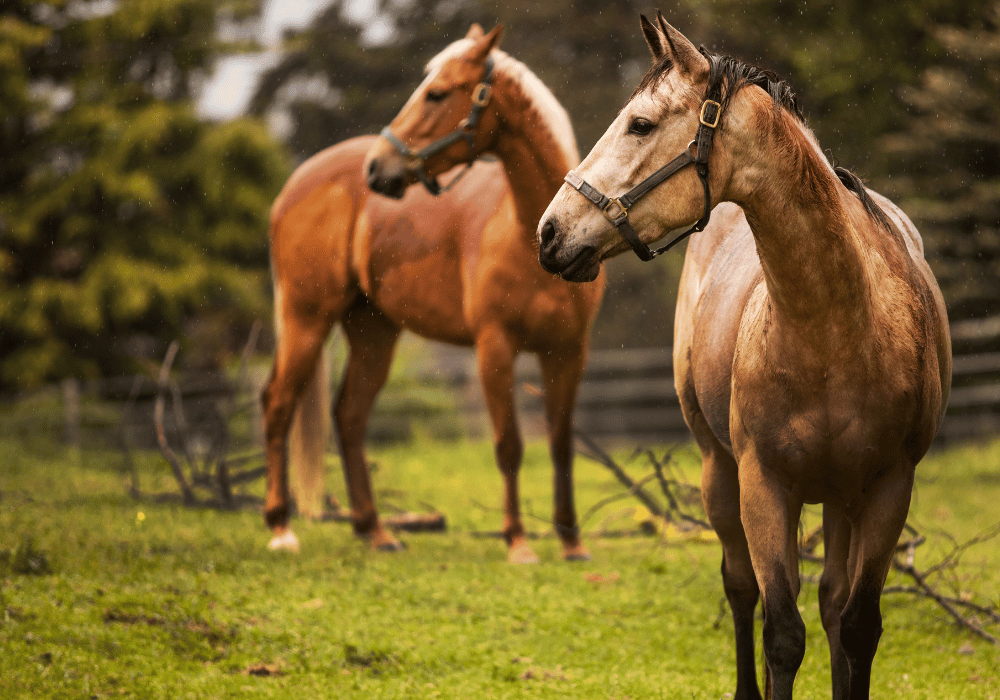Ringworm is a fungal skin infection that can affect horses and humans. Despite its name, ringworm has nothing to do with worms, and it does not always appear in a ring-like pattern! This guide outlines the symptoms of ringworm, how it is treated and how to prevent the spread of ringworm.
What Causes Ringworm in Horses?
Ringworm is usually caused by Trichophyton or Microsporum fungi, which thrive in wet weather.
Ringworm spreads from horse to horse through direct transfer (i.e. horses interacting through mutual grooming) or indirect transfer (i.e. horses coming into contact with infected items or environments, such as grooming equipment, tack, stables or rugs). Indirect transfer can also occur as a result of humans coming into contact with the infected horse and passing the infection onto another horse.
Young, old or immunosuppressed horses are more at risk of developing ringworm. Furthermore, horses with already damaged skin (e.g. due to fly bites or rubs from tack or rugs) are also more likely to catch ringworm because the broken skin is more easily infected.
Symptoms of Ringworm in Horses
Ringworm can appear anywhere on the body, but it is more common in the saddle and girth areas. The incubation period for ringworm can be between six days and six weeks, and the initial symptoms are usually very mild. Early signs of ringworm may include a rash or a bald or sore patch. Tufts of hair may appear slightly raised from the surrounding area, and these tufts can eventually fall out, leaving grey, flaky patches. Whilst severe itching is uncommon, the affected area may appear to be mildly irritated.
The early symptoms of ringworm may not be obvious, or they could be mistaken for other issues such as an insect bite or a sore patch caused by rubbing. However, as ringworm is so contagious, it is important to contact your vet if you are unsure. This is especially important if:
- There is no other obvious cause of the irritation
- Your horse has recently shared transport, stabling or equipment with another horse
- Your horse have recently been to a show, competition or event and interacted with another horse
- Your horse is young, old or immunosuppressed due to medication or a condition such as PPID
Treating Ringworm in Horses
Horses can usually make a full recovery from ringworm without any treatment. However, this is likely to take a number of weeks and in the meantime the ringworm will be more likely to spread to other horses and contaminate the environment. By treating ringworm early, we can minimise the spread to other horses, people and the environment.
Ringworm is usually treated using anti-fungal creams or washes. The type, frequency and duration of treatment used will vary and your vet will be able to advise you on this.
Preventing the Spread of Ringworm
Ringworm fungus produces spores, which can remain dormant for over a year in the environment. Therefore, it is important to prevent the spread of ringworm as far as possible. Outbreaks of ringworm can prevent horses from travelling (e.g. to races and competitions), which can have major financial consequences for businesses. Therefore, it is important for all owners to be aware of the symptoms, contact their vet if they suspect ringworm and take effective biosecurity measures.
It is advisable to keep an infected horse separate from other horses in order to prevent the disease from spreading. Each horse should have its own set of tack, rugs, buckets, grooming equipment and mucking out equipment.
When caring for a horse with ringworm, it is a good idea to wear disposable gloves. This will reduce the chance of humans catching ringworm, and it also helps to prevent the fungus from spreading to other horses. If you suspect that you may have caught ringworm, consult your doctor.
Avonvale Equine Vets | Independent Equine Vet Practice
Our highly qualified and dedicated equine vets, based in Upton, near Banbury, are experienced in diagnosing and treating a range of conditions. We offer free weekly zone visits for routine and non-emergency appointments, covering Warwickshire, Oxfordshire, Gloucestershire and Worcestershire. If you are looking for an independent, reliable equine vet practice with a team of experienced equine vets, Register your horse, pony, donkey or mule with us today.








